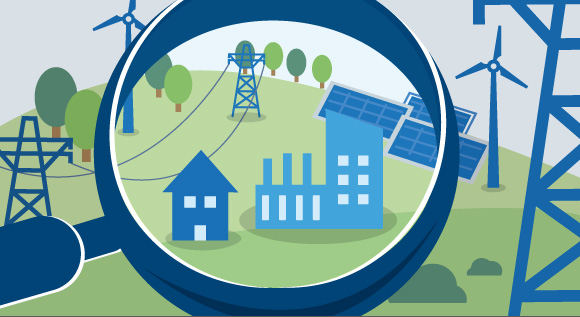What exactly is shore-side electricity?
Why does shore-side electricity have more to do with the sea than the shore and how can it make ocean liners more climate-friendly? To find out the answers, please read on.
 © BMWi
© BMWiThe task: to make ocean-going ships more environmentally friendly. New fuels for ship engines and shore power connections in seaports can help with this.
It is a standard day for the ocean liner. The vessel has already fought its way many nautical miles through the waves of the sea into the port of Hamburg. On its journey, it is powered by marine diesel, which is not exactly good for the climate. But having arrived at the berth, is its environmental impact now over? By no means, because the diesel engines continue to run at the port as well. Here too, the ship must be supplied with electricity – and plenty of it. Exhaust gases such as nitrogen oxides and carbon dioxide waft into the fresh coastal air and harm the environment.
Whilst in port, seagoing vessels should therefore not supply themselves with electricity via their diesel-powered generators, but should use what is known as shore-side electricity in order to better protect the environment. Shore-side electricity therefore has more to do with the sea than with the shore as it describes the onshore electricity that is used to supply water vessels only.
Plugging in container ships, ferries and cruise ships
Using shore-side electricity to operate ships helps protect the climate and improves the air quality in and around the ports. Despite its advantages, shore-side electricity has not been particularly popular with ship-owners as yet. This is because there are still too few such shore-side power installations and therefore few ships worldwide that have been converted to be able to use it. The large quantities of electricity required means that shore-side electricity is also more expensive than using the ship's diesel engine to generate electricity. In fact, the cost for ship owners is around three times higher than if they generate electricity on board.
In order to make the use of shore-side electricity in seaports more economically attractive, Germany's Federal Cabinet adopted an ordinance on grid charges for shore-side electricity and on the textual adjustment of rules in regulatory law in early November 2019. Although this sounds complicated, it is quite simple to explain. Under this new regulation, local electricity grid operators can now offer ship owners the possibility to use their grids at a lower daily rate while their vessels are in port. Up to now, these services could only be used upon payment of an annual or monthly service charge. However, the offer is subject to the condition that the grid operator is permitted to interrupt the supply of shore-side electricity to seagoing vessels if necessary. For the ocean liners, this is no problem as they can quickly go back to using their on-board power generators.
LNG as fuel for ocean liners
Another way to make ocean liners cleaner is by powering them with liquefied natural gas (LNG). The 300-meter-long cruise ship AIDAprima is just one example here. In 2016, AIDAprima was the first cruise ship in the world to generate its electricity in an environmentally friendly way by using LNG. The ship also has a shore-side connection for power supply. Compared to generating its power from conventional marine diesel, AIDAprima was able to reduce its nitrogen oxide emissions by 80 per cent and its carbon emissions by an impressive 20 per cent. In December 2018, the AIDAnova was the first cruise ship to be operated entirely with LNG.

